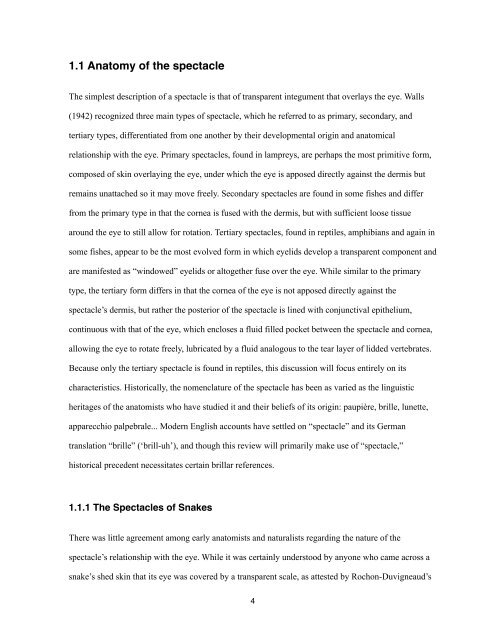Chapter 1, The Reptilian Spectacle - UWSpace - University of ...
Chapter 1, The Reptilian Spectacle - UWSpace - University of ...
Chapter 1, The Reptilian Spectacle - UWSpace - University of ...
You also want an ePaper? Increase the reach of your titles
YUMPU automatically turns print PDFs into web optimized ePapers that Google loves.
1.1 Anatomy <strong>of</strong> the spectacle<br />
<strong>The</strong> simplest description <strong>of</strong> a spectacle is that <strong>of</strong> transparent integument that overlays the eye. Walls<br />
(1942) recognized three main types <strong>of</strong> spectacle, which he referred to as primary, secondary, and<br />
tertiary types, differentiated from one another by their developmental origin and anatomical<br />
relationship with the eye. Primary spectacles, found in lampreys, are perhaps the most primitive form,<br />
composed <strong>of</strong> skin overlaying the eye, under which the eye is apposed directly against the dermis but<br />
remains unattached so it may move freely. Secondary spectacles are found in some fishes and differ<br />
from the primary type in that the cornea is fused with the dermis, but with sufficient loose tissue<br />
around the eye to still allow for rotation. Tertiary spectacles, found in reptiles, amphibians and again in<br />
some fishes, appear to be the most evolved form in which eyelids develop a transparent component and<br />
are manifested as “windowed” eyelids or altogether fuse over the eye. While similar to the primary<br />
type, the tertiary form differs in that the cornea <strong>of</strong> the eye is not apposed directly against the<br />
spectacle’s dermis, but rather the posterior <strong>of</strong> the spectacle is lined with conjunctival epithelium,<br />
continuous with that <strong>of</strong> the eye, which encloses a fluid filled pocket between the spectacle and cornea,<br />
allowing the eye to rotate freely, lubricated by a fluid analogous to the tear layer <strong>of</strong> lidded vertebrates.<br />
Because only the tertiary spectacle is found in reptiles, this discussion will focus entirely on its<br />
characteristics. Historically, the nomenclature <strong>of</strong> the spectacle has been as varied as the linguistic<br />
heritages <strong>of</strong> the anatomists who have studied it and their beliefs <strong>of</strong> its origin: paupière, brille, lunette,<br />
apparecchio palpebrale... Modern English accounts have settled on “spectacle” and its German<br />
translation “brille” (‘brill-uh’), and though this review will primarily make use <strong>of</strong> “spectacle,”<br />
historical precedent necessitates certain brillar references.<br />
1.1.1 <strong>The</strong> <strong>Spectacle</strong>s <strong>of</strong> Snakes<br />
<strong>The</strong>re was little agreement among early anatomists and naturalists regarding the nature <strong>of</strong> the<br />
spectacle’s relationship with the eye. While it was certainly understood by anyone who came across a<br />
snake’s shed skin that its eye was covered by a transparent scale, as attested by Rochon-Duvigneaud’s<br />
4
















